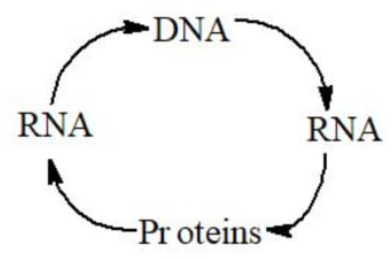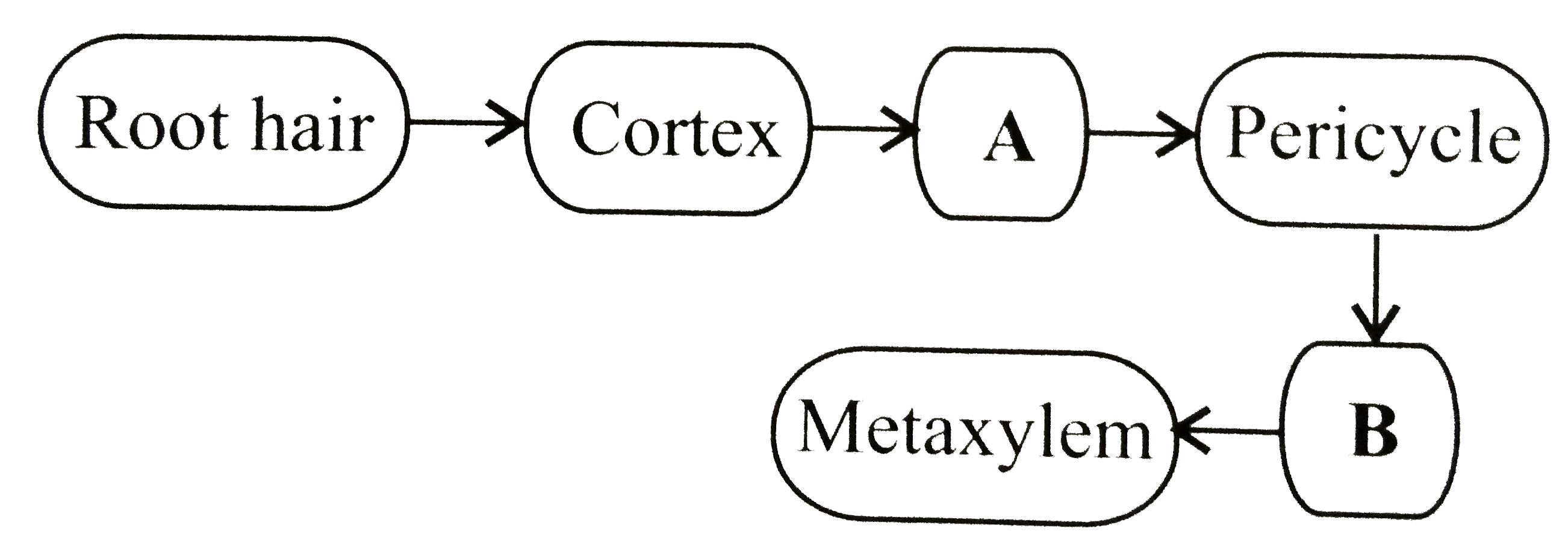Identify the mechanism of the flow of genetic in HIV



DNATranscription−−−−−−−→RNATranslation−−−−−−→Proteins
The correct Answer is:C
To identify the mechanism of the flow of genetic information in HIV, we can break down the process into several key steps:
1. Entry of HIV into the Host Cell:
- HIV (Human Immunodeficiency Virus) enters the body and binds to CD4 receptors on the surface of host cells, particularly T-helper cells.
Hint: Remember that HIV specifically targets immune cells, which is crucial for its pathogenicity.
2. Release of Viral RNA:
- Once inside the host cell, HIV releases its RNA genome into the cytoplasm of the cell.
Hint: The viral RNA is the starting point for the reverse transcription process.
3. Reverse Transcription:
- The viral RNA is converted into DNA by an enzyme called reverse transcriptase. This process is known as reverse transcription.
Hint: Reverse transcription is a unique feature of retroviruses like HIV, which distinguishes it from the central dogma of molecular biology.
4. Formation of Provirus:
- The newly synthesized double-stranded HIV DNA enters the nucleus of the host cell and integrates into the host's DNA. This integrated viral DNA is referred to as a provirus.
Hint: The integration of viral DNA into host DNA is a critical step for the persistence of the virus.
5. Transcription of Provirus:
- The provirus uses the host cell's RNA polymerase to transcribe the viral DNA back into RNA, producing both genomic RNA and messenger RNA (mRNA).
Hint: This step is similar to normal transcription but involves viral DNA.
6. Translation of Viral Proteins:
- The mRNA is then translated into viral proteins by the host's ribosomes. These proteins are essential for the assembly of new virus particles.
Hint: The translation process is crucial for producing the structural components of the virus.
7. Assembly of New Viruses:
- The newly synthesized viral proteins combine with copies of the viral RNA to form new HIV particles, which can then bud off from the host cell to infect other cells.
Hint: This step highlights the infectious cycle of HIV and its ability to spread.
Conclusion:
The correct mechanism of the flow of genetic information in HIV can be summarized as:
- RNA → DNA (via reverse transcription)
- DNA → RNA (via transcription)
- RNA → Proteins (via translation)
Thus, the correct answer is option C: "RNA will form DNA particles with the help of reverse transcription, DNA will form RNA with the help of transcription process, and RNA will form proteins with the help of translation."
- HIV (Human Immunodeficiency Virus) enters the body and binds to CD4 receptors on the surface of host cells, particularly T-helper cells.
- Once inside the host cell, HIV releases its RNA genome into the cytoplasm of the cell.
- The viral RNA is converted into DNA by an enzyme called reverse transcriptase. This process is known as reverse transcription.
- The newly synthesized double-stranded HIV DNA enters the nucleus of the host cell and integrates into the host's DNA. This integrated viral DNA is referred to as a provirus.
- The provirus uses the host cell's RNA polymerase to transcribe the viral DNA back into RNA, producing both genomic RNA and messenger RNA (mRNA).
- The mRNA is then translated into viral proteins by the host's ribosomes. These proteins are essential for the assembly of new virus particles.
- The newly synthesized viral proteins combine with copies of the viral RNA to form new HIV particles, which can then bud off from the host cell to infect other cells.
The correct mechanism of the flow of genetic information in HIV can be summarized as:
- RNA → DNA (via reverse transcription)
- DNA → RNA (via transcription)
- RNA → Proteins (via translation)
Similar Questions
Neutrospora an ascomycetes fungus has been used as a biological tool to understand the mechanism of plant genetics much in the same way as Drosophila has been used to study animal genetics. What makes Neutrospora so important as a genetic tool ?
View SolutionExplain the mechanism of action of restriction endonucleases that makes them suitable for genetic engineering
View Solution
Knowledge Check
The given flow chart represents the flow of genetic information between biomolecules. Identify the processes A,B,C and D and select the correct option.
 AABCDTranslation Transcription ReplicationReverse ),(,,,TranscriptionBABCDReplication Transcription TranslationReverse ),(,,,TranscriptionCABCDReplication Transcription ReverseTranslationTranscriptionDABCDReplication Reverse TranscriptionTranslationTransription
AABCDTranslation Transcription ReplicationReverse ),(,,,TranscriptionBABCDReplication Transcription TranslationReverse ),(,,,TranscriptionCABCDReplication Transcription ReverseTranslationTranscriptionDABCDReplication Reverse TranscriptionTranslationTransriptionThe role of mitosis is not merely to divide a cell into two daughter cells but to ensure genetic continuity from one cell generation to another cell generation. The mechanism ensuring genetic continuity is
Aformation of cells with new chromosomesBformation of two daughter cellsCformation of two cells with identical DNADhalving the chromosome number between the two new cells.In the given flow chart the flow of water is shown from soil to xylem of the root. Identify the tissues involved in steps A nad B
 AA -Hypodermis , B - protoxylemBA - Medullary rays ,B - PhloemCA - Endodermis , B - PhloemDA - "Endodermis", B -"Protoxylem"
AA -Hypodermis , B - protoxylemBA - Medullary rays ,B - PhloemCA - Endodermis , B - PhloemDA - "Endodermis", B -"Protoxylem"
Identify the correct statement in relation to genetically modified organisms
View SolutionIdentify the correct order of organisation of genetic material from largest to smallest :
View SolutionIdentify the correct order of organisation of genetic material from largest to smallest :
View SolutionIdentify the true statement regarding genetic engineering
View SolutionWhich genetic mechanism prevent the self-pollination
View Solution
